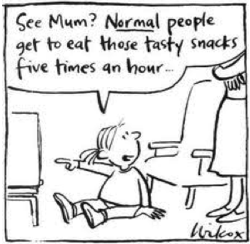Industry self-regulation
Companies spend $1.8 billion a year on food marketing to children.1 Their marketing practices shape kids’ food preferences and requests,2 often undermining parents’ efforts to teach good eating habits and encouraging poor nutrition, which can lead to heart disease, diabetes and other diseases later in life.3
On television, preschoolers see an average of 10 food and beverage ads a day, and children ages 6-11 see a dozen such ads.4 A study of the nutritional content of foods and beverage ads viewed by children found that 84% of ads promoted foods that were high in saturated fat, trans fat, sugars, or sodium.5 Ads for unhealthy foods are particularly prevalent on TV channels targeted at African Americans and Latinos.6,7
In addition, food companies advertise in magazines and on the Internet, induce purchases through toy premiums and prizes, and market their products to children in stores and schools. Researchers found that 73% of the food products marketed to children in a supermarket derived more than 20% of their calories from sugar, and 27% had high levels of sodium.8,9
Currently, 18 food manufacturers and restaurants belong to the industry’s self-regulatory program, the Children’s Food and Beverage Advertising Initiative.10 Others, like Disney, have food marketing policies of their own.11 These efforts have reduced unhealthy food marketing to children somewhat. Between 2003 and 2009, advertising for unhealthy foods to children decreased from 94% of food ads to 86%.12 On the popular children’s television network Nickelodeon, the number of ads for unhealthy foods decreased from 88% of food ads in 2005 to 79% in 2008. As of 2012, 69% of the food ads on Nickelodeon were for unhealthy foods.13
One reason the industry has not made more progress is that two-thirds of food, restaurant, and media companies have no policy to limit junk food marketing to kids.14 Additionally, few retailers have food marketing policies that protect children.
Another reason that progress has been modest is that companies consider foods such as Popsicles, Froot Loops, and Chicken McNuggets healthy to market to kids.15 Additionally, corporate policies apply only to children ages 2 to 11 — excluding tweens, who are also developmentally vulnerable to unhealthy food marketing — and generally fail to cover the full range of techniques the companies use to market foods and beverages to children, such as on-package, in-store, toy giveaways, and many in-school marketing approaches.16
Fruit snack marketing illustrates a gap in corporate policy. Made mostly of sugars, modified cornstarch, artificial flavors, and synthetic food dyes, fruit snacks are more like candy-like jelly beans or gummy bears-than fruit. Nonetheless, even companies participating in the Children’s Food and Beverage Advertising Initiative use children’s favorite characters (such as Disney princesses, Spiderman, and SpongeBob) on the boxes of fruit snacks, because the program does not address on-package marketing.
Corporate marketing policies will only be effective in eliminating unhealthy food marketing to children when:
- All companies participate.
- They adopt stronger nutrition standards to determine which foods and beverages are permissible to market to children.
- They cover all children ages 14 and younger.
- They cover all forms of food and beverage marketing to children.
Your voice matters. Companies care what their customers think. Take action to improve the food marketing landscape by urging companies to do right by children.
Learn more about industry self-regulation
Food industry self-regulation after 10 years: Progress and opportunities to improve food advertising to children
UConn Rudd Center for Food Policy & Obesity
Recommendations for responsible food marketing to children
Healthy Eating Research
Webinar recording: Recommendations for responsible food marketing to children
Report card on food-marketing policies: An analysis of food and entertainment company policies regarding food and beverage marketing to children [pdf]
Center for Science in the Public Interest
Better for who? Revisiting company promises on food marketing to children [pdf]
Center for Science in the Public Interest
Food marketing to children and adolescents: What do parents think? [pdf]
UConn Rudd Center for Food Policy and Obesity
Focus groups with parents: What do they think about food marketing to their kids? [pdf]
UConn Rudd Center for Food Policy and Obesity
Phony fruit snacks
Center for Science in the Public Interest
Infographic: Who’s your nanny?
Center for Science in the Public Interest
References
1. Federal Trade Commission. A review of food marketing to children and adolescents: follow-up report. http://www.ftc.gov/sites/default/files/documents/reports/review-food-marketing-children-and-adolescents-follow-report/121221foodmarketingreport.pdf (accessed September 29, 2015).
2. Institute of Medicine. Food marketing to children: Threat or opportunity? Washington, D.C.: National Academies Press. 2006. https://www.iom.edu/Reports/2005/Food-Marketing-to-Children-and-Youth-Threat-or-Opportunity.aspx (accessed September 29, 2015).
3. U.S. Department of Agriculture (USDA), U.S. Department of Health and Human Services. Dietary Guidelines for Americans 2010. U.S. Government Printing Office, December 2010. http://www.health.gov/dietaryguidelines/2010.asp (accessed September 29, 2015).
4. Harris JL, Vishnudas S, Schwartz MB, Brownell KD. “Redefining ‘Child-Directed Advertising’ to Reduce Unhealthy Television Food Advertising.” American Journal of Preventative Medicine, 2013, vol. 44, pp. 358-364. http://www.uconnruddcenter.org/resources/upload/docs/what/advertising/ChildDirectedAdvertising_AJPM_3.13.pdf (accessed September 29, 2015).
5. Powell LM, Schermbeck RM, Chaloupka FJ. “Nutritional Content of Food and Beverage Products in Television Advertisements Seen on Children’s Programming.” Childhood Obesity, 2013, vol. 9, pp. 524-531.
6. Bridging the Gap, African American Collaborative Obesity Research Network. Targeting food and beverage TV ads at minority and low income children, 2014. http://www.bridgingthegapresearch.org/_asset/xsxm4p/BTG_targeting_TV_ads_brief_Oct_2014.pdf. (accessed September 29, 2015).
7. Thompson DA, Flores G, Ebel B, Christakis DA. “Comida en venta: After-school advertising on Spanish-language television in the United States.” Journal of Pediatrics, 2008, vol. 152, no. 4, pp. 576-581.
8. Elliott CD. “Packaging fun: Analyzing supermarket food messages targeted at children.” Canadian Journal of Communication, 2012, vol. 37, pp. 303-318.
9. Elliott CD, Conlon MJ. “Toddler foods, children’s foods: Assessing sodium in packaged supermarket foods targeted at children.” Public Health Nutrition, 2011, vol. 14, pp. 490-498.
10. Council of Better Business Bureaus. Children’s Food and Beverage Advertising Initiative. http://www.bbb.org/council/the-national-partner-program/national-advertising-review-services/childrens-food-and-beverage-advertising-initiative/ (accessed September 11, 2015).
11. Disney Company. 2014 Disney citizenship performance summary. http://thewaltdisneycompany.com/citizenship/reporting/report-archive (accessed September 29, 2015).
12. Powell L, Schermbeck R, Szczypka G, Chaloupka F, Braunschweig C. “Trends in the nutritional content of TV food advertisements seen by children in the US: Analyses by age, food categories and companies.” Archives of Pediatric and Adolescent Medicine, 2011, vol. 165, pp. 1078-1086. http://www.ncbi.nlm.nih.gov/pmc/articles/PMC3674770/ (accessed September 29, 2015).
13. Center for Science in the Public Interest. Nickelodeon: Marketing obesity to kids. http://cspinet.org/new/pdf/nickelodeon_brief_2013.pdf (accessed September 29, 2015).
14. Wootan MG, Batada A, Balkus O. Report card on food-marketing policies: An analysis of food and entertainment company policies regarding food and beverage marketing to children. Center for Science in the Public Interest, 2010. http://cspinet.org/new/pdf/marketingreportcard.pdf (accessed September 29, 2015).
15. Children’s Food & Beverage Advertising Initiative. Foods and beverages that meet the CFBAI category-specific uniform nutrition criteria that may be in child-directed advertising. http://www.bbb.org/globalassets/shared/media/cfbai/cfbai-product-list-jan-2015.pdf (accessed September 29, 2015).
16. Healthy Eating Research. Recommendations for responsible marketing to children. http://healthyeatingresearch.org/research/recommendations-for-responsible-food-marketing-to-children/ (accessed September 29, 2015).

